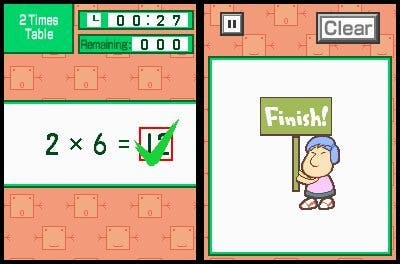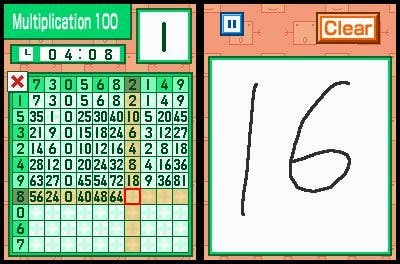Professor Kageyama's Maths Training
Sums it up.
If Nintendo really wants to improve people's lives they should forget about Brain and Sight and Face Training. Much more useful would be Lifestyle Training, a game that teaches you how to live and look like the people in the promotional photographs for Brain and Sight and Face Training. The exercises would train you how to have excellent hair and layer casual sportswear effectively. You would have to practice facial expressions such as rapture, astonishment and boundless joy for when you're playing games. There would be a special bonus mode about how to live in Shoreditch in a flat full of hardwood floors and things made of white.
But no. Nintendo thinks we're still labouring under the impression it's more important to be clever than look like a Hollyoaks, so they've gone and done Professor Kageyama's Maths Training: The Hundred Cell Calculation Method. If that doesn't get you excited, nothing about this title will.
Maths Training features a Daily Test mode which is basically Brain Training except all the exercises involve numbers. You hold the DS sideways like a book and write answers on the touch screen. There are addition and subtraction sums, flash card exercises where you have to identify the number of objects shown and so on. You're judged on how fast you respond plus how many correct answers you give and awarded medals accordingly.
For anyone who is not a child or so rubbish at maths they can't count up their own toes, none of the exercises are tough and so the challenge becomes trying to beat the clock. As with Brain Training, the whole experience is rather dull and the idea you're actually improving your mental abilities seems tenuous. But the Daily Test is designed for short bursts of play, as each test is comprised of three exercises and can only be taken once per day. It's fine for ten minutes or so.
Hard cell

If you do well, you'll move up a level and the test will be slightly harder next time you take it. Before long you'll start doing exercises based around the Hundred Cell Calculation Method. As you've probably guessed, this was developed by Professor Kageyama. As you probably haven't guessed, he works at the Centre for Research and Educational Development at Ritsumeikan University, Kyoto.
He's also deputy headmaster at a primary school and kind of a big deal at the Ministry of Education. He's like a Japanese Carol Vorderman, in other words. (He's not of course. He has serious jobs in academia and politics. He is not paid to stand in a television studio laughing at Richard Stilgoe's amusing wordplay all day. But you try naming another person who achieved fame through maths.)
Hundred Cell Calculation involves practising maths using a 10 x 10 grid. Each square is blank and there are rows of numbers along the top and side of the grid. You match up each top number with each side number and add or subtract or multiply them, depending on what you're practicing. Then you fill in the appropriate square with your answer. Again, you're racing to finish the exercise as fast as possible.
And again, it's dull. The sums are easy (4 + 9, 12 - 5, 3 x 9 etc.) and having to complete them quickly doesn't add a great deal of fun to the proceedings. Apparently the grid is important because it ensures repetition, essential for improving your maths skills. But it just feels like you're doing a series of short, simple sums as you would in the Daily Test, the only difference being it goes on for longer and the answers appear in little boxes.
As for trying to beat time targets, it doesn't help that the DS has real trouble recognising the number 8. It's not too confident with 1, 7 or 3 either. This means you lose valuable seconds as you redraw numbers so the DS can read them. Even if you change your handwriting so they're more likely to be recognised, problems still occur from time to time.
Gridlock

You can practice cell problems and the exercises from Daily Test mode whenever you like. There's also something called Division Marathon where you're given up to 100 dividing sums to complete in a row. This is as fun as it sounds. There's a wireless Study Together mode for up to 15 people. A nice idea for the classroom, but most of us don't have 15 DS-owning friends who'd rather do maths than play Mario Kart.
Which ties in with the main point. Maths Training is an effective educational tool but it's not a particularly entertaining one. For example, if you know a child who is struggling with their times-tables this would be a good way to improve their skills. Chances are they'll jump at the chance to practice maths with a DS rather than a textbook. However, it's also likely you'll have to encourage them to stick at it once the novelty has worn off.
Making maths fun can't be an easy task, but it's still disappointing Nintendo didn't do a better job here. As effective as the Hundred Cell method may be, it would have been good to see more fun exercises included instead of just yet more black-and-white sums. The exercises are too simple for adults; some more advanced sums would have been welcome, or perhaps some based around skills useful in everday life like working out percentages. As it stands Maths Training is not very entertaining, but you could argue it's not meant to be. It's a decent tool for practicing simple maths and if that's all you're looking for, it does the job.

